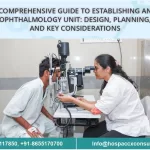Ai Surgeries Equipment Consulting in India
Are you looking for information about the different ways robotic surgeries has impacted the healthcare industry? In this article Hospaccx Healthcare Consultancy has jotted down some key points which will in understanding some of the key points as to why robotics is bringing about some major changes in the field of science and medicine
What is Robotic Surgery?
Robotic surgery is an advanced form of minimally invasive or laparoscopic (small incision) surgery where surgeons use a computer-controlled robot to assist them in certain surgical procedures. The robot’s “hands” have a high degree of dexterity, allowing surgeons the ability to operate in very tight spaces in the body that would otherwise only be accessible through open (long incision) surgery. Compared to open surgery (traditional surgery with incisions), robotic and minimally invasive surgery results in smaller incisions resulting in less pain and scarring. Robotic surgery allows surgeons to perform complex surgical tasks through tiny incisions using robotic technology. Surgical robots are self-powered, computer-controlled devices that can be programmed to aid in the positioning and manipulation of surgical instruments. This provides surgeons with better accuracy, flexibility and control.
Major advantages for surgeons using robotic surgery include:
- Greater visualisation
- Enhanced dexterity
- Greater precision
Surgery is an unpleasant experience at best. The waiting lists can be long depending on available manpower and resources. Thus, surgical robots are the prodigies of surgery. According to market analysis, the industry is about to boom. By 2020, surgical robotics sales are expected to almost double to $6.4 billion.
1. Robots putting CARE back into healthcare
During a hospital stay, patients interact with nurses the most. Like Shiva, the eight- armed Indian goddess, they are there, usually in 12-hour shifts, to draw blood, check your vital signs, monitor your condition and take care of your hygiene if needed. They are often overwhelmed by physically and mentally daunting tasks, and the result is often an unpleasant experience for everyone involved.
Robotic nurses will help carry this burden in the future. They are designed to be able to carry out repetitive and monotonous tasks, so human staff have more energy to deal with issues that require human decision-making skills, creativity, and most of all, care and empathy. One day, blood-drawing robots may relieve nurses from this burdening exercise, they might even perform lab tests without the intervention of humans.
The TUG autonomous mobile delivery robot might also become the favourite of nurses. It is able to carry around a multitude of racks, carts or bins up to 453 kilograms in the form of medications, laboratory specimens or other sensitive materials – so the hospital staff can do other, more important assignments. The TUG is sent or requested using a touch screen interface and upon completing its “mission”, it returns to the charging dock for a sip of energy while it is being loaded
for the next job. The TUG has become commonplace in hospitals and makes over 50,000 deliveries each week in over 140 hospitals throughout the United States.
2. Robots assisting for a better life
But robotics in healthcare means so much more than drawing blood or carrying around racks. With remote-controlled medical robots, caretakers can interact with their patients, check on their living conditions and the need for further appointments. This would help efficiency a great deal by eliminating time-consuming home visits. Some robots combines the very best in cutting-edge technology and human touch to provide frequent check-ins and non-medical care for residents in long-term care settings. By doing so, it reduces the costs of care, while raises patient satisfaction
index by simply being there for the elderly all the time.
3. Telemedicine for increasing accesibility
Patients in remote areas have if given access to high-quality emergency consultations for stroke, cardiovascular, dermatological problems, or any other complaints it can be accessed on a tablet or personal computer, and clinicians can also use the same type of devices as best suits their needs.
4. Robots in Supply chain
Robots can not only undertake monotonous and repetitive tasks, but also those that are potentially dangerous for humans – such as moving heavy boxes or testing solutions. For example, one of Boston Dynamics’ robots, Pet-man, was designed for testing chemical protection clothing for the U.S. military. It’s also useful in emergency situations that have severe perils for humans. Robotics could have a big impact on pharmaceutical distribution chains, too. Robotic medical dispenser systems, medication management solutions help any given facility “right-size” its system for its volume. It is also an emerging best practice that these robots are designed with robust data mining capabilities, so pharmacies can gain valuable insights about their traffic and efficiency all the time. If medical robots
were used for such tasks, pharmacists would have the time and the incentive to participate in the social aspect of healing: educate people of preventive measures, give practical advice and therefore make sure that healthcare truly becomes caring.
5. Disinfection through Robots?
A study states that a large number of patients who go to hospitals come back with something more serious. According to the World Health Organisation, at any given time over 1.4 million people across the globe suffer from a nosocomial or hospital acquired infection (HAI). HAIs account for 2 million cases and about 80,000 deaths a year.
Xenex, a Texas-based company produces a unique robot. It uses high- intensity ultraviolet light to disinfect any space in a healthcare facility quickly and efficiently. The Xenex Robot is more effective in causing cellular damage to microorganisms than any other device designed for disinfection, and thus it reduces the number of HAIs. It’s yet another example of how robotics in healthcare helps hospital staff decrease workload and leads to a more germ-free environment.
6. Companion Robots
With the advancement of robotics and artificial intelligence, social companion robots started to take shape: these human or animal-shaped, smaller or bigger mechanic creatures are able to carry out different tasks and have interactions with humans and their environment and support the elderly from reminding them to take their medication until keeping them company when they feel lonely.
THE KEY PLAYERS IN ROBOTIC SURGERY ACROSS THE GLOBE
Intuitive surgical
Intuitive surgical was founded in 1995 as a way to attempt commercialisation of a robotic surgery prototype developed in conjunction with the U.S Army, originally funded with the interest in remotely performing battlefield surgery. In 1999, Intuitive launched the da Vinci system and in 2000, it became the first robotic surgical system cleared by the FDA for use in general laparoscopic surgery. Since that time, its indications have expanded into cardiothoracic, urologic, gynecologic, and pediatric surgery.
TransEnterix
Founded in 2006, TransEnterix is a medical device company with the goal of “digitising the interface between the surgeon and the patient to improve minimally invasive surgery by addressing the clinical and economic challenges associated with current laparoscopic and robotic options in today’s value-based healthcare environment”.Its enhance Surgical Robotic System is a multi-port robotic system which attempts to address the perceived weaknesses of da Vinci; offering similar surgeon control of multiple robotic arms while providing 3D-HD vision, haptic feedback, and surgeon camera control via eye movements.
Titan medical
Titan Medical is a Toronto-based medical device company currently developing the Single Port Orifice Robotic Technology (SPORT) Surgical System. This system is comprised of a workstation and a robotic platform controlled by the surgeon via hand controls (similar to laparoscopic instruments), foot pedals, and a touchscreen. The robotic platform has a collapsible system that is inserted through a single 25mm incision and features multiple multi-articulated instruments. The instruments use single-use replaceable tips. The system has been validated on animal models and is pending FDA approval.
Human Xtensions
This Israeli startup focuses on developing handheld digital solutions for minimally invasive surgery. Its HandX system, designed as a light-weight, hand-held device which translates a surgeon’s natural hand motions into complex movements inside the patient, received FDA approval in March 2018. It consists of a computerised, reusable hand-piece which translates surgeon hand movements to a single-use articulating instrument tip. The instrument is highly customisable for any skill level, and the company believes that it offers an “affordable alternative to the heavyweight robotic systems that are operated remotely”.
Medrobotics
This Massachusetts-based company has developed the Flex Robotic System, which is based on a flexible, steerable scope that surgeons can use to navigate around anatomy with an integrated 3D high-definition vision system. Once it is in place, the scope can become rigid to provide a stable platform through which flexible instruments can be deployed to perform procedures in a way that is not possible with line-of-sight approaches. Initially approved for limited applications in otolaryngology, the system has received FDA approval for marketing in general surgical, gynaecological and thoracic procedures as of January 2018.
CONCLUSION
To reap the benefits and avoid the potential dangers of such a technological revolution, we need to keep ourselves informed about the strides that science makes so that we can better prepare and adapt to the not-so-distant future where medical robots play a crucial role in the field of healthcare
It is a superficial macro level study. For more details kindly contact Hospaccx Healthcare business consulting Pvt. Ltd on info@hhbc.in or Hospaccx.india@gmail.com or www.hhbc.in.
Related Team Members




















